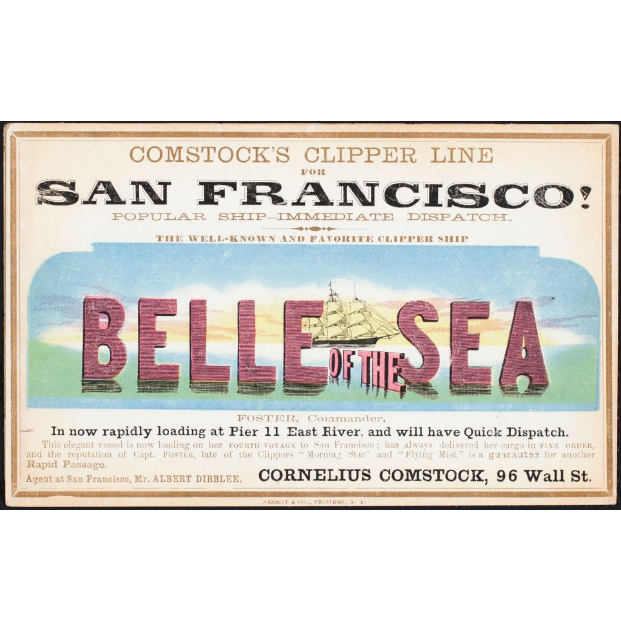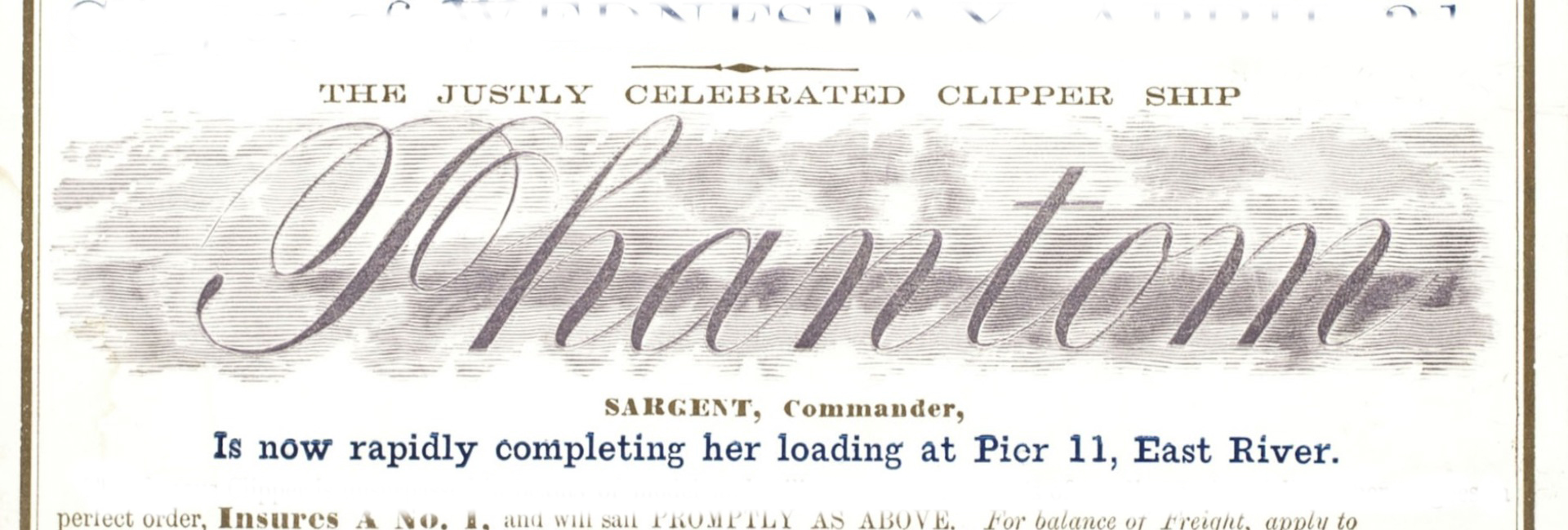
Sailing Ship Card Collection
Sailing ship cards, also known as clipper cards, were multi-colored advertisements popularized in the United States in the mid 1850s. Printing presses designed the handouts to serve as a last-call marketing campaign targeting merchants and exporters in need of a private courier for goods, as well as passenger service. While the majority of these announcements promoted clipper ship availability, barque, schooner, and packet ship voyages also utilized the resource ahead of departure.
The Phillips Library at the Peabody Essex Museum maintains a collection of approximately 1300 sailing ship cards which largely represent journeys from the piers of New York and wharfs of Boston and include stops in San Francisco, Hong Kong, Shanghai, Adelaide, Melbourne, Sydney, and Dunedin. With named ship lines, ports, commanders, captains, consignees, and printers, the ephemera serves as a window into mid-nineteenth century commerical artwork, economic development, and trade operations.
Although domestic marketing aimed to supply American ships with exports and travelers, returning vessels used fraudulent, coercive, and forced means to transport Chinese, Indian, and Filipino people to England, Australia, California, Peru, and Cuba where they would be assigned to an entrapped and enslaved laboring class. Ships featured in the Sailing Ship Card Collection actively participated in this form of human trafficking. For more information on American clipper ships and forced labor, scroll to the bottom of the page.
A note on card artwork
Sailing ship cards near a modern postcard in size and demonstrate commercial printing achievements made in the 1850s. The technical progress accompanied artwork that was often evocative, drawing on contemporary design trends, public fascinations, and moral fears to promote a voyage. Common themes include war, seafaring, mythology, patriotism, Manifest Destiny, sexual objectification, and the racial "other". The cards reflect the social climate and attitudes within the American maritime industry during the antebellum era and throughout the nineteenth century, which was fraught with racist, sexist, and orientalist ideals.
The Phillips Library aims to present these materials with historical accuracy and recognizes the presence and impact of troubling language and imagery. You can view our approach to sensitive material here. We encourage users with questions or concerns about offensive material to contact us via our feedback form.
A note on card artwork
Sailing ship cards near a modern postcard in size and demonstrate commercial printing achievements made in the 1850s. The technical progress accompanied artwork that was often evocative, drawing on contemporary design trends, public fascinations, and moral fears to promote a voyage. Common themes include war, seafaring, mythology, patriotism, Manifest Destiny, sexual objectification, and the racial "other". The cards reflect the social climate and attitudes within the American maritime industry during the antebellum era and throughout the nineteenth century, which was fraught with racist, sexist, and orientalist ideals.
The Phillips Library aims to present these materials with historical accuracy and recognizes the presence and impact of troubling language and imagery. You can view our approach to sensitive material here. We encourage users with questions or concerns about offensive material to contact us via our feedback form.
Highlights from the collection
Clipper ships and human trafficking
In the 1850s, clipper ships dominated the American maritime trade with a speed surpassing that of the barque or schooner. Whereas the Cape Horn route reached across South America and generally facilitated travel and general freight trade between Boston, New York, and California, Pacific clipper routes were particularly successful and contributed to both the expansion of international trade and American economic power. Lucrative lines carried Asian exports and commodities such as soy, silk, furs, tea, hemp, ceramics, sugar cane, and several shipments of opium to Australia, New Zealand, the United States, or onward to England. Ships departing from the same locations with less or no commercial freight utilized these routes as major human trafficking channels from Manila, southern China, British-controlled Hong Kong, and Madras (modern Chennai). In a history entangled with obscured ideas of immigration and opportunity, crewmen transported and displaced hundreds of people on cramped voyages to destinations like Callao, Havana, Melbourne, and San Francisco where they faced grueling and involuntary mining, construction, and agricultural labor conditions.
The Sailing Ship Card Collection held by the Phillips Library at the Peabody Essex Museum does not contain explicit advertisements for human trafficking voyages, but the history of the cards is inextricable from the painful legacy of the clipper trade.
For a more comprehensive history and list of American clipper ships involved in human trafficking, see Glenn A. Knoblock’s 2014 The American Clipper Ship, 1845-1920.
Clipper ships and human trafficking
In the 1850s, clipper ships dominated the American maritime trade with a speed surpassing that of the barque or schooner. Whereas the Cape Horn route reached across South America and generally facilitated travel and general freight trade between Boston, New York, and California, Pacific clipper routes were particularly successful and contributed to both the expansion of international trade and American economic power. Lucrative lines carried Asian exports and commodities such as soy, silk, furs, tea, hemp, ceramics, sugar cane, and several shipments of opium to Australia, New Zealand, the United States, or onward to England. Ships departing from the same locations with less or no commercial freight utilized these routes as major human trafficking channels from Manila, southern China, British-controlled Hong Kong, and Madras (modern Chennai). In a history entangled with obscured ideas of immigration and opportunity, crewmen transported and displaced hundreds of people on cramped voyages to destinations like Callao, Havana, Melbourne, and San Francisco where they faced grueling and involuntary mining, construction, and agricultural labor conditions.
The Sailing Ship Card Collection held by the Phillips Library at the Peabody Essex Museum does not contain explicit advertisements for human trafficking voyages, but the history of the cards is inextricable from the painful legacy of the clipper trade.
For a more comprehensive history and list of American clipper ships involved in human trafficking, see Glenn A. Knoblock’s 2014 The American Clipper Ship, 1845-1920.

Bibliography:
Caruthers, J. Wade. American Pacific Ocean Trade: Its Impact on Foreign Policy and Continental expansion, 1784-1860. Exposition Press, 1973.
Knoblock, Glenn A. The American Clipper Ship, 1845-1920. Jefferson, NC: McFarland & Company Inc., 2014.
Roberts, Bruce D. Clipper Ship Sailing Cards. Bruce D. Roberts, 2007.
Banner and thumbnail images:
Detail from Belle of the Sea (Clipper), Sailing Ship Card Collection, MSS 470, box 1. Phillips Library, Peabody Essex Museum, Rowley, MA.
Detail from Flying Drag (Clipper), ca. 1858, Sailing Ship Card Collection, MSS 470, box 4. Phillips Library, Peabody Essex Museum, Rowley, MA.
Detail from Mary L. Sutton (Clipper), Sailing Ship Card Collection, MSS 470, box 6. Phillips Library, Peabody Essex Museum, Rowley, MA.
Detail from Phantom (Clipper), Sailing Ship Card Collection, MSS 470, box 8. Phillips Library, Peabody Essex Museum, Rowley, MA.
Bibliography:
Caruthers, J. Wade. American Pacific Ocean Trade: Its Impact on Foreign Policy and Continental expansion, 1784-1860. Exposition Press, 1973.
Knoblock, Glenn A. The American Clipper Ship, 1845-1920. Jefferson, NC: McFarland & Company Inc., 2014.
Roberts, Bruce D. Clipper Ship Sailing Cards. Bruce D. Roberts, 2007.
Banner and thumbnail images:
Detail from Belle of the Sea (Clipper), Sailing Ship Card Collection, MSS 470, box 1. Phillips Library, Peabody Essex Museum, Rowley, MA.
Detail from Flying Drag (Clipper), ca. 1858, Sailing Ship Card Collection, MSS 470, box 4. Phillips Library, Peabody Essex Museum, Rowley, MA.
Detail from Mary L. Sutton (Clipper), Sailing Ship Card Collection, MSS 470, box 6. Phillips Library, Peabody Essex Museum, Rowley, MA.
Detail from Phantom (Clipper), Sailing Ship Card Collection, MSS 470, box 8. Phillips Library, Peabody Essex Museum, Rowley, MA.
